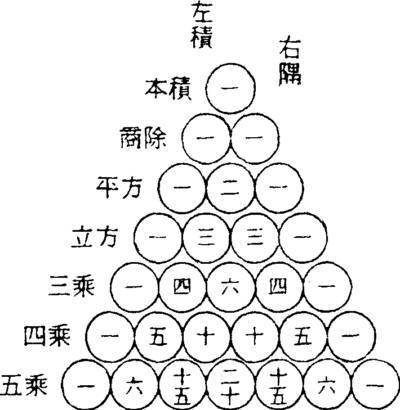Chapter 33 Section 3 Jiaxian Triangle
Jia Xian called his opening method Licheng release the lock.Unlocking a lock is a metaphor for opening a square like opening a lock; Tang and Song calendar mathematicians called a calculation table with some calculation constants called Licheng; the Licheng unlocking method is a method of opening a square with the help of a certain calculation table.Jia Xian called the establishment of the prescribing method the origin of the prescribing method, and today it is called the Jia Xian Triangle.The current middle school textbooks and some pamphlets refer to it as Yang Hui's triangle, which is a falsehood.In fact, it is preserved in Yang Hui's book, and Yang Hui clearly pointed out that "Jia Xian used this technique".
The Jiaxian triangle is a triangle in which the coefficients of the expansion of the binomial of the whole power (a+b) (n=0,1,2,3...) are arranged, as shown in Figure 29.There are five sentences under this picture: "The left lap is the accumulation of numbers, and the right lap is the corner calculation. Those in the middle and Tibetan are all cheap. Use the cheap to take advantage of the business, and get rid of it." ("Detailed Explanation" quoted in "Yongle Dadian" Nine Chapters "Algorithms") The first three sentences illustrate the structure of Jia Xian's triangle: the numbers on the outermost left and right oblique lines are the product a and Calculate the coefficient of x in the corner, and the middle numbers two, three, three, four, six, four, ... are each cheap.The last two sentences explain the function of each coefficient in Licheng's unlocking method.The functions of two, three, and three in square extraction and cubic extraction have already been seen above; The effect is similar to this.The proposal of Jia Xian's triangle shows that Jia Xian has actually extended the method of establishing and releasing locks to high-order powers, which is a major breakthrough.

Figure 29 Jiaxian Triangle
After the Jiaxian Triangle, there is a method of making, that is, "increasing and multiplying methods to find cheapness": list the number of squares, count one by the corner, and increase from the bottom to the first place, and stop at the first place. Repeat the calculation by the corner as before, increasing and descending One seeks it." ("Detailed Explanation of the Nine Chapters" Algorithm cited in "Yongle Dadian") Jia Xian also gave a detailed guide for finding the sixth power, as shown on page 110.Finally, six, fifteen, twenty, fifteen, and six are the various values of the sixth power.Obviously, this method can be used to find the value of any high power.In other words, Jia Xian has been able to write the Jia Xian triangle to any number of layers.
Later, Zhu Shijie used two sets of parallel lines to connect the numbers in Jia Xian's triangle, as shown in Figure 30, which shows that Jia Xian's triangle has also become Zhu Shijie's main tool to solve the problem of summation of high-order arithmetic series.
In the 15th century, the Arab mathematician Al-Qassi expressed the same meaning of a triangle as a right triangle. Many mathematicians in Europe in the 16th and 17th centuries proposed this triangle, among which Pascal is the most famous and is called Pascal's triangle.

Figure 29 Jiaxian Triangle
